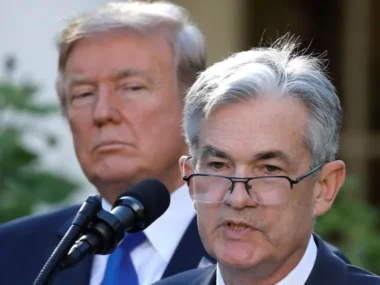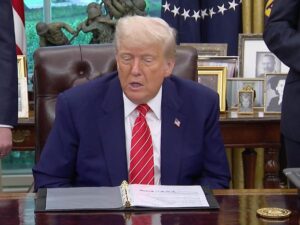The International Monetary Fund (IMF) has made its biggest downgrade to the US economic growth forecast among advanced economies, citing uncertainty from trade tariffs. The US is now projected to grow by 1.8% this year, down sharply from January’s 2.7% estimate.
The IMF warns that rising tariffs and global uncertainty will significantly slow down worldwide economic growth.
The UK’s growth forecast has also been lowered to 1.1%, though it’s expected to outpace Germany, France, and Italy. However, the UK is set to face the highest inflation among advanced economies at 3.1%, driven mainly by rising utility bills.
These updates come ahead of the IMF and World Bank’s spring meetings in Washington. IMF chief economist Pierre-Olivier Gourinchas noted the global economy is still recovering from the severe shocks of recent years and is once again under pressure.

The Fund stated that rising tariffs and ongoing uncertainty will cause a marked slowdown in global economic growth.
On Tuesday, US President Donald Trump stated he had “no intention of firing” Federal Reserve Chair Jerome Powell, despite recent strong criticism. Market concerns over a possible dismissal contributed to recent sell-offs.
Trump has introduced multiple tariffs this year, taxing imported goods to the US. The US has imposed tariffs up to 145% on Chinese imports, with China responding with tariffs of up to 125% on US products. Additionally, a 10% tax has been placed on goods from most other countries, though steeper tariffs have been temporarily suspended for some nations.
Trump argues that tariffs will boost domestic consumption, increase tax revenue, and drive significant investment within the US.
However, the IMF cautions that tariffs could hurt global trade, especially given the complexity of modern supply chains. IMF chief economist Pierre-Olivier Gourinchas noted that trade uncertainty played a key role in the downward revision of growth forecasts. He explained that in response to such uncertainty, many businesses are likely to delay investment and reduce spending.
As a result, the IMF now expects global growth to slow to 2.8% this year—down from a previous 3.3% forecast—and to reach 3.0% by 2026.
The IMF attributed its downgrade of the US growth outlook to heightened policy uncertainty, escalating trade tensions, and weaker-than-anticipated consumer spending. It also warned that tariffs are likely to suppress growth further in 2026.
The Fund now estimates a 40% chance of a US recession this year, up from 25% in October. Supporting this, the Institute of International Finance forecast a mild US recession later in 2025, with expected economic contractions in the third and fourth quarters.
China’s growth projection has been revised down to 4% from 4.6%, while the UK’s forecast was lowered due to the effects of tariffs, increased borrowing costs, and dampened household spending driven by higher utility bills. Nonetheless, the IMF’s 2025 forecast for the UK—1.4%—aligns closely with the Office for Budget Responsibility’s 1% estimate.
UK Chancellor Rachel Reeves responded by saying the forecast confirms the UK remains the fastest-growing G7 economy in Europe, crediting ongoing reforms. She also said she would be in Washington to advocate for British trade interests. In contrast, Conservative shadow chancellor Mel Stride called the downgraded outlook a “worrying indictment” of Labour’s economic strategy and noted a significant upward revision to the UK’s inflation forecast.
Additional IMF projections include:
- Eurozone growth reduced to 0.8% for 2025, rebounding to 1.2% by 2026 due to increased German public spending.
- Spain is the only advanced economy with an upgraded 2025 forecast—up to 2.5% from 2.3%—aided by post-flood reconstruction.
- Canada’s 2025 outlook was cut to 1.4% from 2%, reflecting global tensions and trade uncertainty.
- Mexico saw the steepest downgrade, now expected to shrink by 0.3%, a reversal from the earlier forecast of 1.4% growth.
The IMF emphasized that forecasts are inherently uncertain, especially under current volatile conditions. These figures, based on data available as of April 4—shortly after the US announced broad new tariffs—represent its “reference forecast.” However, IMF chief economist Pierre-Olivier Gourinchas noted that multiple outcomes remain possible due to unpredictable trade policies and varied tariff effects globally.
While the US has temporarily paused many tariffs, it sharply increased duties on Chinese goods. The IMF said this pause hasn’t significantly altered its outlook, as overall tariff levels remain elevated and uncertainty persists.











